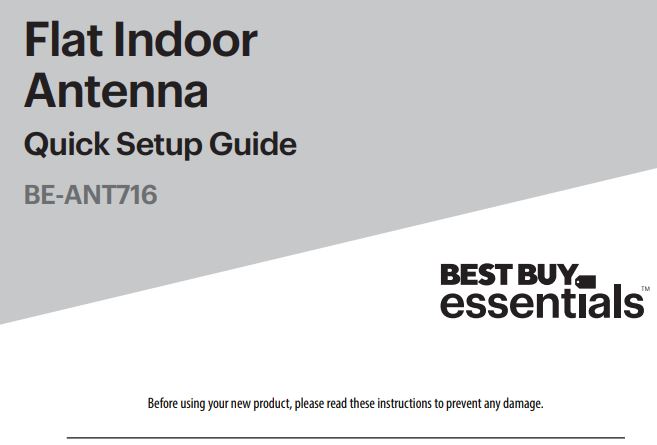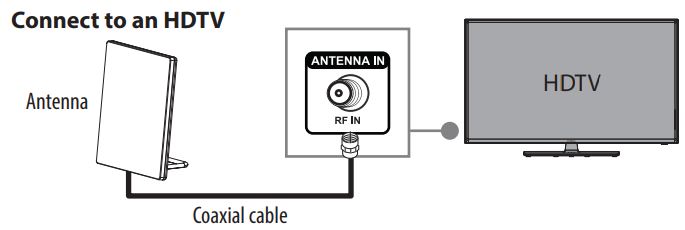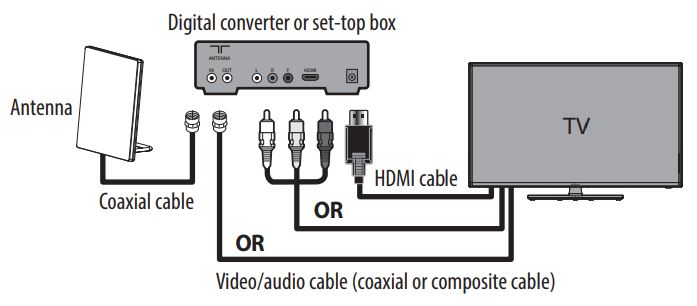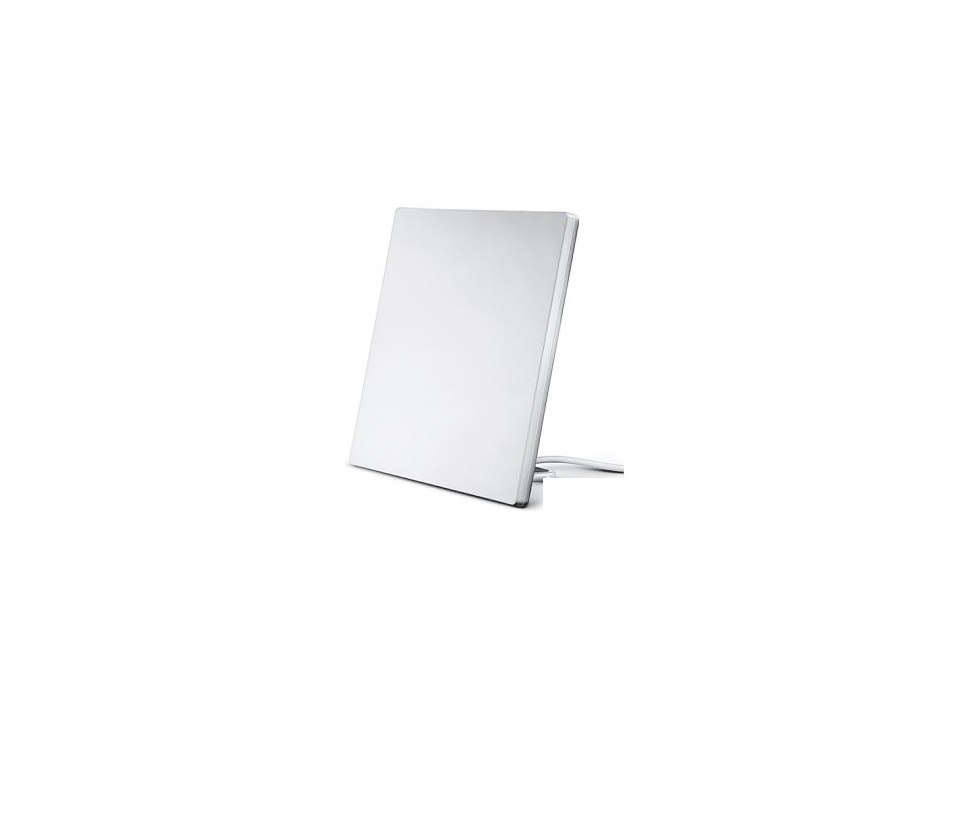BEST BUY essentials BE-ANT716 Flat Indoor Antenna User Guide

This antenna is specially designed for digital over-the-air TV broadcast reception. It can receive all of the TV signals available in your area in the VHF and UHF bands. Range and performance can be impacted by several external factors. Refer to tips and troubleshooting for recommendations to improve reception.
Package contents
- HDTV antenna
- Antenna stand
- Quick Setup Guide
Features
- Receive free local HDTV broadcasts
- Flat profile design fits with any décor
- Multiple placement options: stand mount, lay at, or hang on wall
- 5 ft. (1.52 m) integrated coaxial cable Stand

Setting up and using your antenna Positioning the antenna1 Select a location to place your antenna. See “Tips for Better Reception” for more information.Note: This is an indoor antenna. Do not place it outside.2 Choose a mounting method:

Connecting the antennaIf you have an HDTV with a digital TV (ATSC) tuner, you can connect the antenna directly to the HDTV. Older TVs may require a separate digital TV tuner or digital converter box.1 Connect the end of the antenna’s coaxial cable to the coaxial jack on the back of your TV digital converter box or set-top box.

ORConnect to a TV through a digital converter box
- Connect the coaxial cable to your digital converter box or set-top box, then connect a video/audio cable (such as an HDMI, coaxial, or AV cable) from your converter box or set-top box to your TV.

2 Turn on your TV, then press input or source to select the input for your antenna (usually labeled TV).3 Open your TV’s Setup menu, then select the “scan” or “channel scan” option. Your TV automatically searches for available channels in your area. Refer to your TV manual for detailed instructions.
Tips for better reception
- Keep the antenna away from sources of interference, such as air conditioners, elevators, hair dryers, or microwave ovens.
- Place the antenna near a window.
- Install the antenna as high as possible to avoid possible obstacles between the antenna and transmission tower. Obstacles may cause temporary signal loss.
- Run a channel scan every time you move your antenna.
- If possible, position your antenna toward the transmission tower.
- To determine which channels are available in your area, visit www.antennaweb.org. Type in your zip code to get help with antenna placement.
- Test the antenna in multiple locations to find the strongest signal.
- This antenna is an indoor antenna. Do not place it outside.
- Run a channel scan monthly to make sure that you are receiving all possible channels.
- Some TVs have a signal strength indicator that can help with antenna placement. See your TV manual to see if your TV has this feature.
- This antenna works with any TV or device with an ATSC tuner. Refer to the device manual to check compatibility.
Troubleshooting
I cannot nd any channels.
- Make sure that you have selected the correct input on your TV.
- Go to the menu on your TV or set top box, such as a cable/satellite box or streaming media device, and rescan the channels.
- Make sure that all your connections are correct and secure.
- Adjust your antenna, then rescan for available channels on your TV or set top box.
- Make sure that you are connected to a TV or set top box with an ATSC tuner.
The picture quality is good on some channels and poor or no reception on others.
- Adjust your antenna, then scan for available channels on your TV or set top box.
- Keep the antenna away from sources of interference such as air conditioners, hair dryers, and microwave ovens.
- Your antenna may be too far from the broadcast antenna to receive an adequate signal. The signal may also be affected by obstructions between the broadcast antenna and your antenna.
- Make sure that the signal strength from the antenna is adequate. Some TVs have a signal strength indicator. See your TV manual to see if your TV has this feature.
- If you use a UHF/VHF amplifier to boost the signal level, make sure that it is operating correctly.
I don’t know what digital TV reception I get in my area.
- To determine which channels are available in your area, visit www.antennaweb.org. Type in your zip code to get help with antenna placement.
Not all channels are available after performing a channel scan.
- Adjust your antenna, then scan for available channels on yourTV or set top box.
- Make sure that the signal strength from the antenna is adequate. Some TVs have a signal strength indicator. See your TV manual to see if your TV has this feature.
Specifications
- Dimensions (H×W×D): 8.1 × 9 × .7 in. (20.5 × 23 × 1.7 cm)
- Range: 30 miles (48 Kilometers)Note: Range will vary depending on a wide range of environmental and geographic factors
- Frequency range:
- VHF: 174-230 MHz
- UHF: 470-860 MHz
- Cable length: 5 ft. (1.52 m)
- Impedance: 75 ohm
One-year limited warrantyVisit www.bestbuy.com/bestbuyessentials for details.
Contact Best Buy essentialsFor customer service, call 866-597-8427 (U.S. and Canada) www.bestbuy.com/bestbuyessentials
Best Buy essentials is a trademark of Best Buy and its affiliated companies. Distributed by Best Buy Purchasing, LLC 7601 Penn Ave South, Richfield, MN 55423 U.S.A. ©2021 Best Buy. All rights reserved.
References
[xyz-ips snippet=”download-snippet”]

